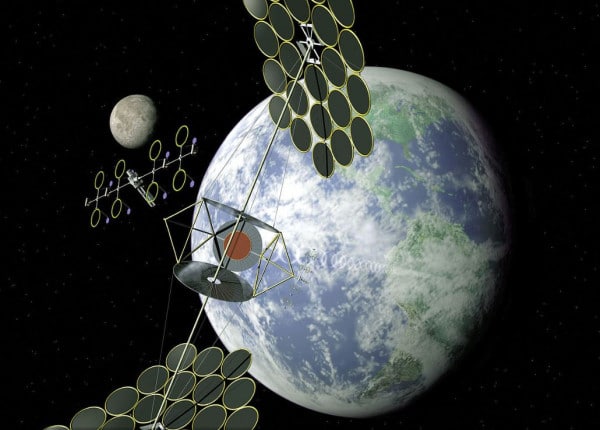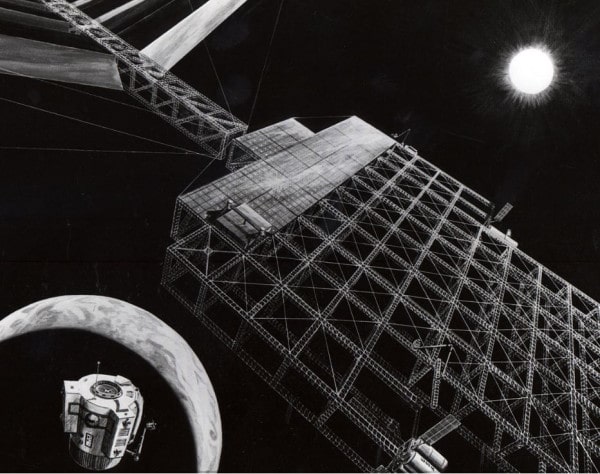The idea sounds like a sci-fi script.
To be precise, it is.
It was first described in the short story Reason by Isaac Asimov, published in 1941 in an American science fiction magazine and included in 1950 in the famous book I, the Robot by the Russian-American author and professor Biochemist .
In his day, the script seemed crazy.
But eighty years later, the operation of a space station that will collect energy from the Sun and transmit it to other planets - in this case on Earth - with microwaves is being considered as a viable, environmentally feasible and technically feasible solution.
Research has been going on for half a century, starting with the USA and NASA.
The relevant technology partly exists and is being developed.
And so, various countries have begun to consider the prospect of implementing the so-called "Space-Based Solar Energy", now known by the acronym "SBSP" (Space-based solar power).
The central idea is for a huge satellite, kilometers long, that will collect solar energy through thousands of photovoltaic panels.
It will transmit it to Earth via microwave (or laser according to another theory).
And then, this power beam will be collected by receivers, which will convert it into electricity and distribute it through a network to households and businesses.
The energy race of Space
Officially motivated by the achievement of climate neutrality targets by about the middle of the century and now driven by the ongoing energy crisis, various countries are now actively entering the SBSP "game".
This technology is mentioned, for example, in the official British government program Net Zero Innovation, which has set 2050 as the time horizon for zero emissions.
Following a positive feasibility study by consulting firm Frazer-Nash Consultancy, Downing Street is reportedly now seriously considering a 16 XNUMX billion proposal to build a solar power station in space.
The project, known as the Space Energy Initiative, includes a satellite about 5 kilometers long and weighing 2.000 tons, which will be assembled and maintained by robots.
Initially with small tests - and if the plan succeeds - the British station could theoretically become operational in 2040, producing 2 gigawatts (GW) of energy.
Enough to power about 1,5 million homes and about the equivalent of two nuclear power plants, but only a fraction of the 76 GW of British production capacity.
In the US, however, pilot projects are already underway.
The world-renowned California Institute of Technology is developing high-efficiency photovoltaic systems as well as an optimized energy conversion and transmission system in space.
In the meantime, the U.S. Naval Research Laboratory (NRL) - a research center for the Navy and the US Marines - tested solar panels and energy conversion systems into space by 2020.
At the same time, Washington is funding $ 180 million in research by aerospace and defense technology company Northrop Grumman and the U.S. Air Force Research Laboratory (AFRL) to develop the SBSP in the military.
In China, meanwhile, work has begun months ago to build SBSP test facilities in Chongqing, with the goal of developing an operating system by 2035.
The ultimate goal is to launch the Asian giant's first solar space station at a distance of about 36.000 km from Earth, with a capacity to produce 1GW of energy by 2050.
Japan, whose Space Agency is working feverishly to present its own system by 2025, is also impatient. Something that has been set as a national goal since 2008, and in fact by law.
Similar projects are reportedly being carried out by other countries, such as Russia and India, while the interest of the European Space Agency (ESA) is now strong, which has funded 13 proposals for their further development.

Source: NASA, Wikipedia
Plus and minus
Proponents of SBSP technology say it could provide solutions to multiple problems.
By using giant satellites in high geostationary orbit, solar energy can be collected 24 hours a day, regardless of the weather and sunshine on Earth.
Therefore, electricity generation will be continuous. Possibility, which until now is provided only through polluting fossil fuels and nuclear energy.
By the middle of the century - about thirty years from now - global energy demand is estimated to have doubled, while the use of fossil fuels to combat climate change has been blocked.
On the other hand, however, various critical issues remain open with SBSP.
The secure wireless transmission of energy to the Earth must be ensured, as well as its efficiency (with the existing technological data, there will be significant losses of the collected solar energy).
The question remains the degree of efficiency and durability of photovoltaic systems in the long run in space, due to the intense solar radiation, as well as the existing risk of their destruction by space debris.
But above all, at least at this stage, the robotic assembly of the huge satellites in space, on such a large scale.
This is a huge challenge.
Both from an economic and an environmental point of view, as multiple launches will be required to transport the components into space.

Source: NASA, Wikipedia
It is estimated that the cost could be reduced by reusing satellite buses, which have not yet been developed - although companies such as Elon Musk's SpaceX are working in this direction.
"The high market demand for space launches created by Space Based Solar Power is likely to accelerate efforts to develop even more affordable and fully reusable spacecraft," the British government said in a feasibility study.
In any case, the authors emphasize, "the successful development of SBSP will require a substantial R&D program, with continued efforts over the next two decades and government commitment, until the technology is sufficiently mature for private funding."
Also "there may be a willingness to work with our physical partners, including Europe, members of the Five Eyes intelligence alliance" - namely the US, Britain, Canada, Australia, New Zealand - "and Japan on a political solar development program space-based energy ", the study points out, thus giving a further geopolitical dimension to the issue;
